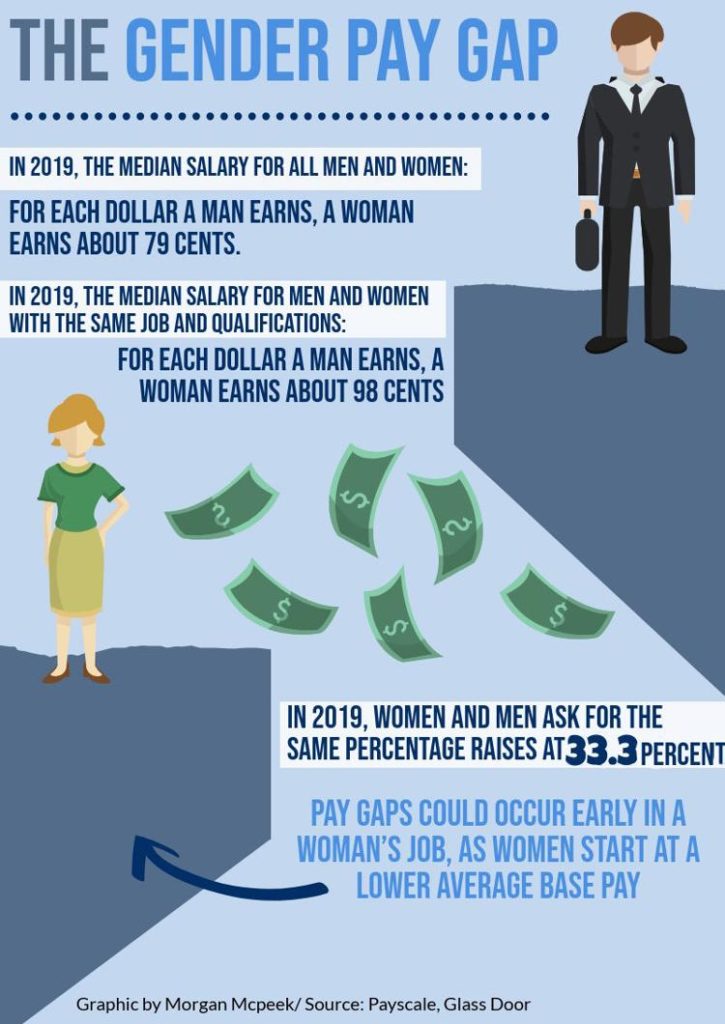
As female college graduates are entering the workforce, discrimination is an issue they may have to overcome. With this unfair treatment, a woman’s pay can also be at risk.
The gender pay gap is a form of discrimination against women in the workplace that consists of the pay inequality between men and women.
In 2019, according to the Payscale website, gender discrimination that takes place in pay still exists despite shrinking the gender pay gap. Regarding the uncontrolled gender pay gap, which consists of the median salary for all men and women, a woman earns about 79 cents for every dollar a man earns.
Texas Tech Jerry S. Rawls College of Business Administration Dean Margaret Williams said women are given advice to ask for high pay.
“That’s certainly not the only way to address the gender pay gap,” she said. “I would also say that every employer needs to constantly examine their own pay systems to determine the extent in which there’s a gender pay gap and to take steps to correct that themselves.”
Because there are a variety of causes of the gender pay gap, Williams said women should not be made responsible to close it. The management of a job should understand why the pay gap is present in their workplace.
“It’s easy to spot,” Williams said regarding the gap. “It’s a little more difficult to understand why that gap exists.”
Whether it be the type of position or the seniority of a position, Williams said there are different causes one must consider to comprehend why the gender pay gap is present.
Despite society’s task to eliminate the gender pay gap in the workplace, Williams said women still have to understand their value in their current position and job.
“I think women need to be aware, educate themselves of the impact of the choices they make on their current and future pay,” Williams said. “I would say this for any employee, not just women, but you should do the research to understand what they can command in the labor market, what salary they can command in the labor market.”
Regardless of the causes that lead to gender discrimination in the workplace, Williams said there are a variety of reasons why a woman may not speak out against the unfair treatment they are facing.
Because of the fear of being fired, Williams said speaking up about an issue in the workplace can be problematic for a woman.
“I think it’s really difficult to expect the person who is being discriminated against or the person who is suffering that treatment to be the person to correct the problem,” she said. “You’re in a very vulnerable position.”
To resolve the gender pay gap they are facing, a woman might consult a variety of resources within their job.
Jerry Stevens, instructor in the Rawls College of Business, said going to a direct supervisor is the first step anyone should take when facing discrimination.
“Lay out your side of the story and how you feel you are being discriminated against,” he said. “If it’s in the pay area, then certainly that’s one that you want to bring up to your supervisor.”
Going to the person above one’s supervisor or human resources are methods Stevens said people can use if they cannot resolve the pay issue with their supervisor. If other options are exhausted, he said one can go to the Equal Employment Opportunity Commission.
“The first step should be to your immediate supervisor to get an explanation from them” Stevens said. “You might want to get an explanation from that individual in writing.”
Through their supervisor’s explanation, Stevens said people can understand the reasons why they are not receiving equal pay compared to their co-workers.
“What most people may not understand that in any pay situation is there are ranges of pay,” he said. “Simply because you don’t make exactly the same dollar, that doesn’t mean there is in fact discrimination.”
Just because a man’s pay is higher than a woman’s pay, Stevens said that does not mean discrimination is taking place. If both pays are within the set pay range, such as $50,000 to $63,000, he said discrimination is not occurring.
Whether it be pay ranges or one’s value in a workplace, dealing with the gender pay gap could require a woman to consider a variety of aspects.
Wendy-Adele Humphrey, associate dean for assessment and strategic initiatives in the Tech School of Law and vice chair of the Tech President’s Gender Equity Council, said pay equity is one facet of gender discrimination.
To understand the extent of the gender pay gap, Humphrey said there are different factors that can lead to pay discrimination among genders.
“A lot of different things go into the gap,” she said regarding how a woman’s education level, work experience, age or ethnicity can cause them to be treated unfairly. “Because there are laws in place to protect people from this type of discrimination, most workplaces have some type of policies or procedures for reporting.”
In addition to consulting HR or the EEOC, Humphrey said there are other approaches to overcoming the strain of the gender pay gap.
“To whom you reach out to and consult with will depend upon the type of discriminatory behavior,” she said. “It varies on a case-by-case basis.”
Depending on the issue a woman is facing regarding pay, Humphrey said the solution to the problem can vary.
Regardless of the resources available to help workers, Humphrey said men and women should be agents of change in the workplace and eliminate the gender pay gap to help women dealing with pay inequality.
“Talking to a trusted colleague about it,” she said. “Depending on the situation and how extreme it may or may not be, even counseling early on just to talk through the process.”
Article Credit: DailytoReador
